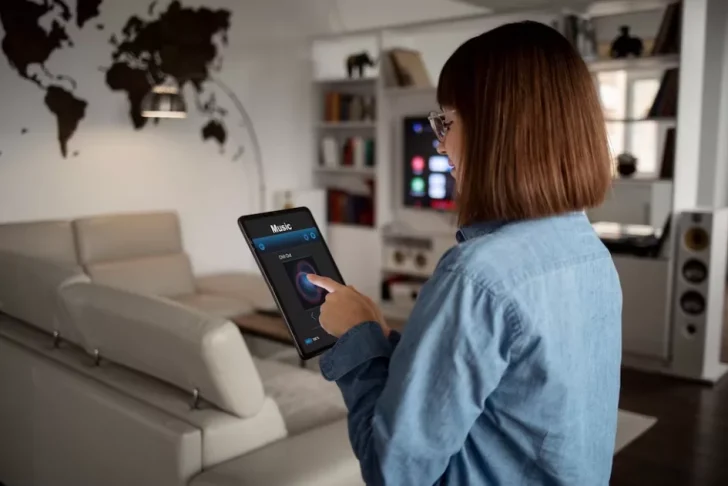In recent years, the advent of home automation and voice control has revolutionized how we interact with our living spaces. What was once the realm of science fiction is now an integral part of modern home design. Automation and voice control have become central to the concept of a smart home, where technology enhances comfort, convenience, and energy efficiency. As more people seek to streamline their daily routines and create spaces that adapt to their needs, integrating automation and voice control is an excellent way to improve both functionality and lifestyle.
If you’re new to the world of home automation and voice control, the thought of transforming your home may seem overwhelming. However, with the right devices and a bit of planning, you can seamlessly incorporate these technologies into your daily life. In this article, we will explore how to improve your home with automation and voice control, offering practical insights on how to get started and make the most of these innovations.
What is Home Automation and Voice Control?
Before diving into the specifics, it’s important to understand what we mean by home automation and voice control.
Home automation refers to the use of technology to remotely control and monitor various home systems and devices. This includes anything from lighting and heating to security and entertainment. Automation can make your home more efficient by allowing devices to operate on schedules, respond to environmental changes, or adjust to your habits.
Voice control allows you to operate devices and systems in your home through voice commands. With the integration of virtual assistants such as Amazon Alexa, Google Assistant, or Apple Siri, you can control smart devices in your home hands-free, making everyday tasks more convenient.
When combined, these technologies work together to create a cohesive and streamlined living environment. The beauty of home automation and voice control is that they are both customizable and scalable, meaning you can start small and gradually expand as you become more familiar with the possibilities.
The Benefits of Home Automation and Voice Control
There are several key benefits to incorporating home automation and voice control into your home. Here are some of the most notable advantages:
-
Convenience and Ease of Use
The most immediate benefit of automation and voice control is convenience. Imagine waking up in the morning and, with a simple voice command, your bedroom lights gradually brighten to simulate the rising sun. Your thermostat adjusts to the perfect temperature, and your coffee machine begins brewing. When you leave the house, the lights turn off, the thermostat lowers, and the security system activates — all without lifting a finger.
Voice control allows you to perform tasks hands-free. You can adjust the thermostat, turn on the lights, or play music simply by speaking. This is particularly helpful when your hands are full, whether you’re cooking, cleaning, or entertaining guests.
-
Energy Efficiency
Home automation can also help you become more energy-efficient. By programming your heating and cooling systems to adjust automatically based on your schedule, you can reduce unnecessary energy consumption. For example, your thermostat can lower the temperature while you’re at work and warm up the house before you return home, ensuring that you’re never heating or cooling an empty house.
Smart lighting systems can be programmed to turn off when a room is empty or dim when adequate natural light is available. These adjustments save energy, reduce your carbon footprint, and ultimately lower your utility bills.
-
Security and Peace of Mind
Home automation can significantly enhance your home’s security. Smart locks, doorbell cameras, and security systems allow you to monitor your home remotely, giving you peace of mind whether you’re at work, on vacation, or simply away for a few hours.
Voice control adds another layer of security by allowing you to lock doors or arm the security system hands-free. Additionally, voice assistants can send notifications to your phone if any unusual activity is detected, allowing you to take action immediately.
-
Personalization and Customization
With home automation, your home can adapt to your preferences. Lights, temperature, and entertainment can all be customized to suit your routine. For example, if you typically enjoy dimmed lighting and soft music in the evening, your automation system can be set to activate these settings at a specific time every day.
As your system learns your habits, it can become even more efficient. Some automation systems can sense when you’re home and adjust settings accordingly, ensuring you always have the right ambiance when you need it.
Getting Started with Automation and Voice Control
If you’re ready to improve your home with automation and voice control, here are some practical steps to help you get started:
-
Start with a Voice Assistant
The cornerstone of most smart homes is a voice assistant, such as Amazon Alexa, Google Assistant, or Apple Siri. These virtual assistants can control a wide range of smart devices in your home, from lighting to thermostats to entertainment systems. They act as a hub that connects all your devices, allowing you to control everything with simple voice commands.
When choosing a voice assistant, consider compatibility with other smart devices. For example, Amazon Alexa is compatible with a wide range of smart home products, making it an excellent choice for beginners.
-
Install Smart Lighting
Lighting is one of the easiest areas to automate in your home. Smart bulbs such as Philips Hue or LIFX can be controlled via voice commands or through an app. You can adjust brightness, change the color of the lights, or even set up lighting schedules.
Automating your lighting is not only convenient but can also create the right ambiance for different activities. Whether you’re hosting a dinner party or unwinding after a long day, you can easily customize your lighting to match the mood.
-
Upgrade Your Thermostat
A smart thermostat is one of the most impactful devices you can add to your home. Systems like Nest and Ecobee can be programmed to adjust the temperature based on your schedule. They can also learn your preferences over time, optimizing temperature settings for comfort and energy savings.
Most smart thermostats can be controlled via voice commands, so you can adjust the temperature hands-free as you move through your day. They can also be controlled remotely, allowing you to adjust the settings when you’re away from home.
-
Enhance Your Security System
Smart home security devices are an essential part of home automation. From video doorbells like Ring to motion detectors, cameras, and smart locks, these systems provide an added layer of protection.
Voice control can make managing your security system even easier. For instance, you can ask your voice assistant whether your doors are locked or even lock them remotely with a simple command. Additionally, smart cameras can send alerts to your phone, keeping you informed about any activity around your home.
-
Add Smart Appliances
For those looking to go further with home automation, consider adding smart appliances such as refrigerators, washing machines, and coffee makers. These appliances can be controlled via voice or apps, offering added convenience.
For example, smart refrigerators can track expiration dates and inventory, while smart washing machines can be scheduled to start when it’s most convenient for you. These devices not only save time but can also make your home more energy-efficient.
-
Create Automation Routines
One of the best features of home automation is the ability to create custom routines. You can set up routines that trigger multiple actions with a single command. For example, you can create a “Good Morning” routine that gradually brightens the lights, starts the coffee maker, and adjusts the thermostat to your preferred temperature.
These routines can be programmed for specific times or triggered by actions, such as when you arrive home or leave the house. Over time, your automation system can become more attuned to your lifestyle, making it easier to manage your home.
Conclusion
Home automation and voice control are not just futuristic concepts; they are practical tools that can make your life easier, safer, and more energy-efficient. Whether you’re looking to automate lighting, enhance security, or create a personalized environment, these technologies offer endless possibilities for improvement. By starting with a voice assistant and gradually adding smart devices, you can transform your home into a modern, connected living space that adapts to your needs. With the right automation systems in place, your home can be more comfortable, convenient, and secure than ever before.


















